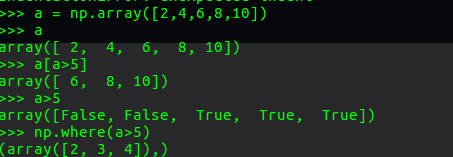大体要用的函数就是squeeze/ unsequeeze /nonzero/ where /> /< /.new().fill_()/ torch.cat()/torch.sort
经常看到的变量名 keep /index gt_max gt_argmax
目录
0. torch.nonzero返回满足条件的行列,[m,n] —> k行2列
1、排除anchor跑到图像外面,将all_anchors变成anchors
3. np.argmax(a,axis = none) & torch.max(a,1)
5.. expand_as(tensor) 有点想repeat之后再view
开始总结:

摘自faster rcnn pytorch中
需要注意><号在np和torch中的不同np直接返回true/false,torch中返回1/0/。
0. torch.nonzero返回满足条件的行列,[m,n] —> k行2列
>>> torch.nonzero(torch.Tensor([[0.6, 0.0, 0.0, 0.0],
... [0.0, 0.4, 0.0, 0.0],
... [0.0, 0.0, 1.2, 0.0],
... [0.0, 0.0, 0.0,-0.4]]))
0 0
1 1
2 2
3 3
[torch.LongTensor of size 4x2]
1、排除anchor跑到图像外面,将all_anchors变成anchors
keep = (xmin>=0 & ymin>= & xmax<= w & ymax<=h) # 根据 keep 判断,返回所有的行,满足条件的为1,不满足的为0.
inds_inside =torch.nonzero(keep).view(-1) #nonzero去掉0,只返回1,也就是符合条件的行号,然后变成(m,)
all_anchors[inds_inside,:] # 按inds_inside取出符合条件的行,一般行代表一个样本

# keep 是一个[n,1]
keep = ((all_anchors[:, 0] >= -self._allowed_border) &
(all_anchors[:, 1] >= -self._allowed_border) &
(all_anchors[:, 2] < long(im_info[0][1]) + self._allowed_border) &
(all_anchors[:, 3] < long(im_info[0][0]) + self._allowed_border))
# inds_inside 是一个[m,1]
inds_inside = torch.nonzero(keep).view(-1)
anchors = all_anchors[inds_inside, :]
2. > < np.where

np.where(condition)
返回一个行向量,一个列向量。
所以大多后面加一个[0] np.where(x>4)[0]
a = np.array([2,4,6,8,10])
a[np.where(a > 5)] # 等价于 a[a>5] array([ 6, 8, 10])
np.where(condition, x, y)
满足条件(condition),输出x,不满足输出y。image = np.where(image >= 240, 255,image)
3. np.argmax(a,axis = none) & torch.max(a,1)
np.argmax返回的索引 如果axis=1,二维表示在每一行里面找列最大的,只返回索引。高维度的可以这样理解:在axis轴对应的维数里寻找最大。你比如:a.shape=(2,3,4), np.argmax(a,axis=2),按4个数4个数的找最大,返回(2,3)。
torch.max(a,1)[0] 返回最大值
torch.max(a,1)[1] 返回索引
4. torch.stack((a,b,c),dim)
沿着一个新维度对输入张量序列进行连接。 序列中所有的张量都应该为相同形状。
注意这个函数和concatenate是不同的,torch的concatenate函数是torch.cat,是在已有的维度上拼接,而stack是建立一个新的维度,然后再在该纬度上进行拼接。
参数:
sqequence (Sequence) – 待连接的张量序列
dim (int) – 插入的维度。必须介于 0 与 待连接的张量序列数之间。要看合成后的
类似的维度的操作,可以看我上面reshape的说明,必须要理解填充的顺序。从后缘维度开始填充。
你比如:a=[[1,2,3],[4,5,9],[7,8,9]] b=[[1,2,3],[4,5,9],[7,8,9]] ,c=-[[1,2,3],[4,5,9],[7,8,9]] ,
torch.stack((a,b,c),0)0是最后一个填充的,从最大层次也就是最外面的括号看
>>>【[[1,2,3],[4,5,9],[7,8,9]],[[1,2,3],[4,5,9],[7,8,9]],-[[1,2,3],[4,5,9],[7,8,9]] 】
torch.stack((a,b,c),1)从中间的括号开始看
>>> [[[1,2,3],[1,2,3],-[1,2,3]],[4,5,9],[4,5,9],-[4,5,9]...]
torch.stack((a,b,c),2)从最里面的一个元素一个元素竖着开始看
>>> [[[1,1,-1],[2,2,-2],[3,3,-3]],[....]
在比如一维度数组stack
a=([1,2,3]) b=([1,2,3])
torch.stack((a,b),0)
>>>[[1,2,3],[1,2,3]]
torch.stack((a,b),1)
>>>[[1,1][2,2],[3,3]]
5.. expand_as(tensor) 有点想repeat之后再view
torch版本的bbox_transform_batch有用。将tensor扩展为参数tensor的大小。类似于人为广播操作。但必须只有一个维度是不相等的。
>>> a=torch.rand(2,1,4)
>>> b=torch.rand(2,4,4)
>>> a
tensor([[[ 0.1828, 0.9803, 0.4630, 0.7553]],
[[ 0.3949, 0.8661, 0.8884, 0.3982]]])
>>> b
tensor([[[ 0.5678, 0.7193, 0.6781, 0.9207],
[ 0.4690, 0.4737, 0.2638, 0.9247],
[ 0.9315, 0.8202, 0.5217, 0.8444],
[ 0.5279, 0.5673, 0.6443, 0.4649]],
[[ 0.3587, 0.8476, 0.6263, 0.1106],
[ 0.4531, 0.0974, 0.9504, 0.6684],
[ 0.5585, 0.9721, 0.1965, 0.3138],
[ 0.6662, 0.2503, 0.9760, 0.0737]]])
>>> a.expand_as(b)
tensor([[[ 0.1828, 0.9803, 0.4630, 0.7553],
[ 0.1828, 0.9803, 0.4630, 0.7553],
[ 0.1828, 0.9803, 0.4630, 0.7553],
[ 0.1828, 0.9803, 0.4630, 0.7553]],
[[ 0.3949, 0.8661, 0.8884, 0.3982],
[ 0.3949, 0.8661, 0.8884, 0.3982],
[ 0.3949, 0.8661, 0.8884, 0.3982],
[ 0.3949, 0.8661, 0.8884, 0.3982]]])
6. torch.equal(a,b) & a.eq(b)
![]()
a.eq(b)
torch.eq(input, other, out=None) → Tensor
比较元素相等性。第二个参数可为一个数或与第一个参数同类型形状的张量。
参数:
input (Tensor) – 待比较张量
other (Tensor or float) – 比较张量或数
out (Tensor, optional) – 输出张量,须为 ByteTensor类型 or 与input同类型
返回值: 一个 torch.ByteTensor 张量,包含了每个位置的比较结果(相等为1,不等为0 )
返回类型: Tensor
例子:
>>> torch.eq(torch.Tensor([[1, 2], [3, 4]]), torch.Tensor([[1, 1], [4, 4]]))
1 0
0 1
[torch.ByteTensor of size 2x2]
torch.equal
torch.equal(tensor1, tensor2) → bool
如果两个张量有相同的形状和元素值,则返回True ,否则 False。
例子:
>>> torch.equal(torch.Tensor([1, 2]), torch.Tensor([1, 2]))
True